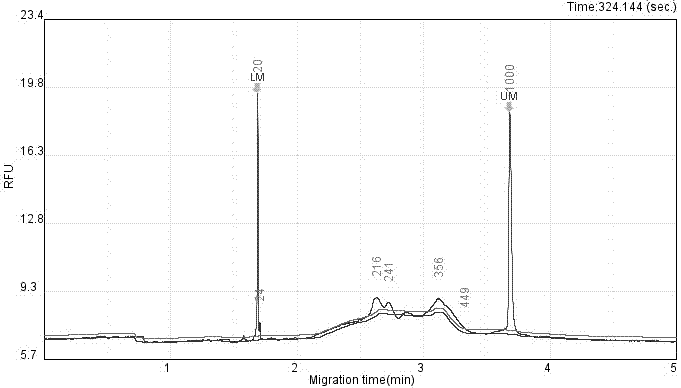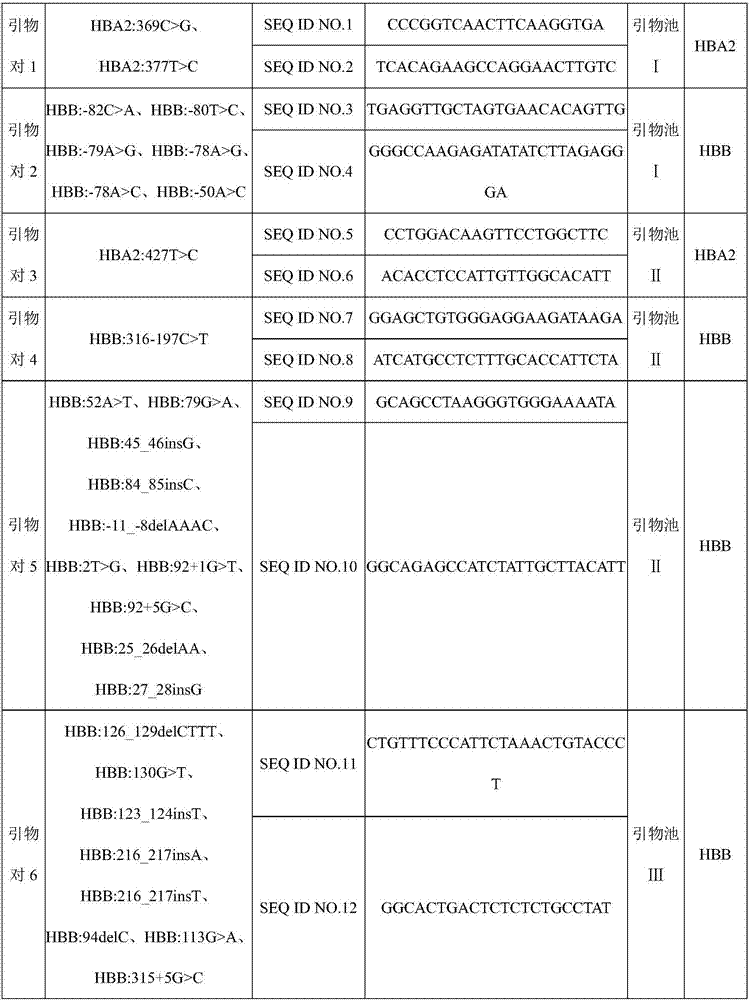Set of primer group and method capable of simultaneously detecting mediterranean anemia, epicophosis, phenylketonuria and hepatolenticular degeneration
A technology for phenylketonuria and hepatoloids, which is applied in biochemical equipment and methods, recombinant DNA technology, and microbial measurement/inspection, can solve problems such as poor prognosis, and achieve good repeatability and high efficiency.
- Summary
- Abstract
- Description
- Claims
- Application Information
AI Technical Summary
Problems solved by technology
Method used
Image
Examples
Embodiment 1
[0045] The design of embodiment 1 primer set
[0046] 1. Determine the detection range of genes related to the four genetic diseases of thalassemia, deafness, phenylketonuria and hepatolenticular degeneration; design primers for each mutation site of the relevant pathogenic genes of these genetic diseases , to avoid the formation of primer-dimers and primers with high GC content, and finally select primers with an annealing temperature of 60 °C. All designed primers were compared by BLAST on the NCBI database. There should be no complementary sequences between the primers and they should have high specificity. The primer pairs adjacent to the position of the human genome Hg19 reference sequence were assigned to different primer pools to avoid the generation of overlap, and the primer pairs with similar GC content were assigned to the same primer pool. Finally, the primer set of the present invention is optimized, including three primer pools: primer pool I, primer pool II and...
Embodiment 2
[0063] Example 2 Detection method for genes related to thalassemia, deafness, phenylketonuria, and hepatolenticular degeneration
[0064] Using the primer set designed in Example 1, the peripheral whole blood genomic DNA of the sample was used as a template, combined with the multiplex PCR method to construct the library, and the high-throughput sequencing method was used to sequence the library, and the sequencing data was analyzed to detect and analyze gene mutations.
[0065] 1. Reagents used in this method: DNeasy Blood&Tissue Kit, Qubit dsDNA HS AssayKit, Ion Ampliseq Library Kit 2.0, Ion Xpress Barcode adapters1-16, absolute ethanol, AMPure XP beads, Ion PI HI-Q Sequencing 200Kit, Ion PI HI -Q OT2 200Kit, Dynabeads Myone Streptavidin C1, Ion PI Chip Kit v2, Isopropanol, Sodium Hydroxide, etc.
[0066] 2. Detection method
[0067] (1) The detection template is DNA from peripheral whole blood;
[0068] (2) Amplification of the target sequence
[0069] For each sample, t...
Embodiment 3
[0111] Example 3 Application of detection method in wild-type human genome
[0112] 1. Collection, transportation and preservation of specimens:
[0113] (1) Specimen collection: The specimen is human peripheral whole blood, and the above 58 loci were tested by clinical first-generation sequencing, and the results were all wild type. 2 mL of venous blood was taken routinely and treated with EDTA anticoagulant.
[0114] (2) Storage: It can be detected immediately, and stored at -20±5°C for 2 years.
[0115] (3) Transportation: Store and transport at 4°C.
[0116] 2. Extraction of human genomic DNA
[0117] DNA was extracted using DNeasy Blood & Tissue Kit extraction kit. The specific steps are as follows: Add 20 μL proteinase K, 200 μL whole blood sample and 20 μL AL buffer to a 1.5mL EP tube, mix well and incubate at 56°C for 10 minutes; add 200 μL absolute ethanol, mix well and transfer all the liquid to the spin column , centrifuge at 8000rpm for 1 minute, discard the l...
PUM
 Login to View More
Login to View More Abstract
Description
Claims
Application Information
 Login to View More
Login to View More - R&D
- Intellectual Property
- Life Sciences
- Materials
- Tech Scout
- Unparalleled Data Quality
- Higher Quality Content
- 60% Fewer Hallucinations
Browse by: Latest US Patents, China's latest patents, Technical Efficacy Thesaurus, Application Domain, Technology Topic, Popular Technical Reports.
© 2025 PatSnap. All rights reserved.Legal|Privacy policy|Modern Slavery Act Transparency Statement|Sitemap|About US| Contact US: help@patsnap.com



